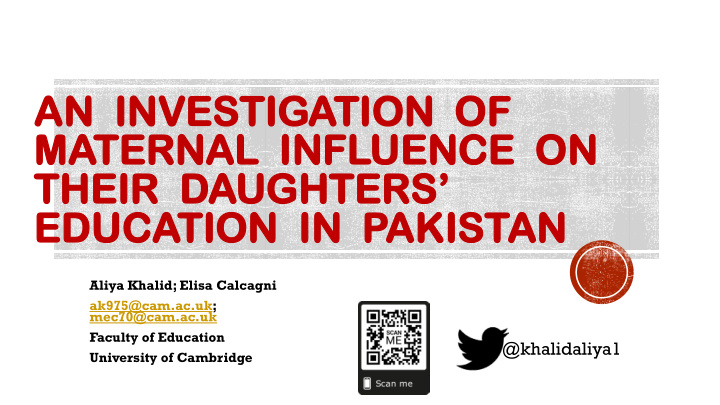



AN I INV NVEST ESTIG IGATIO ION N O OF MATERNAL L I INF NFLUEN UENCE E O ON N THEIR IR DAUG UGHT HTER ERS’ S’ EDUCA CATIO ION N IN N PAKIST KISTAN Aliya Khalid; Elisa Calcagni ak975@cam.ac.uk; mec70@cam.ac.uk Faculty of Education @khalidaliya1 University of Cambridge
The e Liter erature R e Review Literature on Pakistan: Relationship between Mothers’ education or empowerment, and daughters’ school enrollments.
The R e Rese search Q Quest stion In what ways do mothers from rural Punjab Pakistan conceptualize education for their daughters? And how do they strategize for their daughters’ education?
The R e Rese search Q Quest stion-cont ontinue ued This research question was unpacked by using theoretical concepts drawn from the ‘The Capabilities Approach’ and the ‘Cooperative Conflict Model’ of household income distribution.
Methods A And A Anal alysi sis 12 mothers, with different schooling statuses, their husbands and daughters, were interviewed for this paper from one village neighborhood in Sargodha Pakistan. Semi structured interviews were developed using the theoretical framework and data were collected for a qualitative study. Thematic analysis (Braun and Clarke, 2006) was done to identify categories of ‘conceptualization’ and ‘strategies’ in the data. Two logics of intra-case and cross-case analysis were used. We went back and forth between the two to reach substantial results.
Vill illage c conte text & t & sample le Sample size 12 mothers Overall literacy rate in the village Low Accessible schools to mothers 2 Number of schooled mothers 5 mothers (with at least 5 years of education) Average completed years of 6 years schooling (of educated mothers)
Selecting t two c case ases f s for i in-depth a anal alysi sis
Sele lectin ting Two C Cases es: Density ity in in actio tions
Conceptualization Of Education
Household 7777 Hh 7777: Nusrat’s Conceptualization 1. Nusrat’s history • Completed 8 years of education • She was raised in a middle class family. Both of her parents worked to earn a living. Her mother held a strong position in the family. 2. Nusrat’s Milieu • Husband and in-laws were not supportive of education • Her mother supported education strongly 3. Daughter’s opinions • Has clear targets. Has told her mother about them. 4 . Nusrat’s state of mind • She has a stronger fall-back • Values her own opinion • Believe her job is more imp as a mother
Household 7777
Household 48 Hh 48: Shakeela’s Conceptualization 1. Shakeela’s history Completed 2 years of school, was married early • Had a prosperous childhood that she refers to as ‘free’. • 2. Shakeela’s Milieu Husband not motivated for higher edu Lack of family support 3. Daughter’s opinions Elder daughters strongly support younger sister’s edu 4. Shakeela’s state of mind Has weaker fall-back Values her interests and responsibilities as a parent
Household 48
COMPARISON AND DISCUSSION ‘Hope is always associated with communion, no matter how 1. interior it may be’ (An introduction to the metaphysics of hope, Marcel in Jacobs 2005) Freire's concept of ‘critical hope (Pedagogy of Hope, 1992) is 2. defined as, pushing beyond simply dreaming of a better day and into consciously thinking about how to work towards a collective vision (Jacobs, 2005) What these mothers share is ‘critical hope’ for their daughters’ 3. education. This according to Freire gives them the agency to work towards these goals.
@khalidaliya1 Aliya Khalid, ak975@cam.ac.uk Elisa Calcagni, mec70@cam.ac.uk
Recommend
More recommend